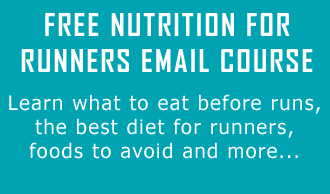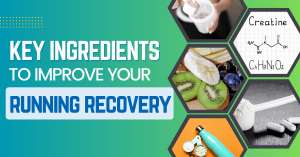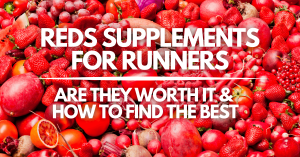This guest post was written by Heather Caplan
For some runners, the way they eat is an integral part of their training plan.
For others, nutrition for runners is a second thought, or may not be paid much attention to until it becomes a problem.
Either way, runner diet advice can vary greatly depending on who you talk to. One of the most common questions I get asked as a coach and registered dietitian is this:
“What should I eat?”
While I don’t believe there’s one best diet for runners, or humans, I do believe some nutrition plan for runners offer more benefits than others.
Sports nutrition is a relatively young science, so we’re always learning!
When you strip nutrition down to the basics—macronutrients (carbohydrates, proteins, and fats) and micronutrients (vitamins and minerals)—there are many scientific truths.
This article will review some of the latest runner diet plan options available, including the trends and fads in runners nutrition, covering the research that has been done thus far (if any), and what to consider when choosing a running nutrition plan for you.
Whether you are looking for the best diet for runners to lose weight or you want to focus on performance nutrition for runners, there is a best way of eating for you, and hopefully today we can help you find it.

How Does What Food You Eat Impact Your Run?
Our body and brain need energy from macronutrients to go fast and far, and need a balance of micronutrients to keep all the systems (e.g. digestive, cardiovascular, muscular, etc.) happy.
Making small improvements by eating more nutritionally-dense foods means it’s more than likely you’ll notice an improvement in your fitness as well.
Without an adequate amount of calories and micronutrients, the body will fail to make progress in endurance, strength, or speed.
When do you need to change your diet?
There’s no time like the present!
Seriously, there is no “wrong” time to assess your diet.
Actually, there is one wrong time:
The day before, or morning of, a race, after all, we never want to change anything just before a big race!
It doesn’t matter if you’re training or “just” running for health, fitness, stress-relief, etc.—assessing the foods you eat to increase your awareness of how they make you feel will almost always lead to positive improvements.
Chances are these improvements will include better sleep, more stable energy levels throughout the day, more energy for your running routine, and faster recovery.
Ever wonder about an elite runner diet?
We share what some of the best former elite runners in the US eat to fuel their training as well as the diets of Kenyan runners in different articles.
If your runner diet needs some work, it is time to reconsider your food choices.
Here is one way to begin:
Start with a food log. This is an easy way to identify your food habits, stress-eating triggers, hunger levels, and diet variety.
If you’re interested in professional help with your diet assessment, seek a registered dietitian to review this log with you. Nancy Clark talked about how important this can be in her interview on the podcast recently.
What is the Ideal Nutrition for Runners?
The following are the diet trends I consider the most common among athletes right now.
Read on to get the gist of each, and end with points to consider for yourself and your lifestyle.
Low-carb high-fat (LCHF)
Following a LCHF diet means that, of your total daily energy intake, no more than 25 percent of energy (e.g. calories) is from carbohydrates, and at least 60 percent is from fat.
This leaves a maximum of 15 percent of calories to come from protein.
Fat is a longer-lasting fuel source, and the body can store more energy in fat than it can in carbohydrate.
A LCHF diet may train the body to use fat as fuel more efficiently, meaning you run farther on the body’s stored energy
What does that mean?
Your body burns more body fat, making some consider it as the best diet for runners to lose weight.
This approach seems to be most popular as an ultra runner diet.
Research suggests that it may take as few as five days of training with LCHF to “enhance fat-burning capacity,” and after only two to three weeks on this diet, one “achieves adaptation to high blood ketone concentrations.” (1)
More traditional nutrition recommendations for runners have included a much higher intake of carbohydrates (e.g. 45-55 percent of total energy), and about half the amount of fat (20-35 percent of total energy).
But keep this in mind:
Carbohydrate intake recommendations for runners are more often calculated by grams of carbohydrate per body weight (e.g. 7-10 grams of CHO per kilogram of bodyweight). (2)
Where can I learn more?
Runner’s Connect: “Is a High-Fat Diet Right for Me?”
Paleo
The theory goes that the Western diet has become too heavily focused grains, but our paleolithic ancestors survived and thrived on protein and plants.
So, why not go back to that?
It seems “paleo” diets have some grey areas, but the guidelines largely include this: no dairy, soy, grains (gluten), legumes, or processed sugars (and usually no alcohol).
Some paleo eaters avoid eating a lot of fruit, and focus mainly on animal proteins.
It’s a restrictive diet built on largely disputed claims about the human body’s need for, and capacity to adequately digest, modern agriculture products such as grains, legumes, soy, etc.
By eliminating these food groups, paleo eaters hope to reduce inflammation and avoid assumed food intolerances.
It often centers on whole and fresh foods, omitting many highly processed foods.
The paleo diet varies from traditional sports nutrition as it tends to be high protein, high fat, and low carbohydrate.
The main sources of carbohydrates are starchy vegetables and fruits.
Research on this diet is limited, and has focused more on high-intensity strength training than it has on endurance sports.
The restrictive nature of the diet draws criticism, as athletes may benefit from the nutrient profile of legumes, whole grains, and dairy (if tolerated).
Where can I learn more?
The Huffington Post: “The Pros and Cons of the Paleo Diet”
Vegetarian
While not necessarily a “trend,” vegetarianism has experienced a recent surge in popularity, if you will.
More restaurants and grocery stores are offering vegetarian dishes and products than ever before.
Vegetarianism spans from lacto-ovo vegetarians (includes dairy and eggs) to vegan (no animals products at all, including honey, eggs, dairy, etc.).
Several elite endurance runners and pro athletes follow a vegetarian or vegan diet and perform well.
Some have claimed that eliminating animal products has even improved their athletic ability and recovery.
Research has shown that vegetarian diets are sufficient for athletes in a variety of sports and at any level, but has not yet scientifically proven either a beneficial or detrimental effect as compared to an omnivore diet.
However, the following micronutrients may require additional attention for vegans and vegetarians, as a plant-based diet does not always provide adequate amounts: iron, vitamin B12, calcium, and vitamin D. (3)
Where can I learn more?
Vegetarian Resource Group: “Eating to Exercise and Compete: Sports Nutrition Guidelines for the Vegetarian”
Low FODMAP
The low FODMAP diet shouldn’t be considered a trend, but rather a relatively new (or newly popular) approach to identifying foods that may aggravate irritable bowel symptoms.
This diet reduces the intake of certain types of sugars (fermentable oligosaccharides, disaccharides, monosaccharides and polyols) that may cause bowel discomfort and/or inflammation.
It should only be followed if suggested by a primary care physician and/or nutrition professional, and solely under their guidance.
Where can I learn more?
International Foundation for Functional Gastrointestinal Disorders: “Guidelines for a low FODMAP diet”
IIFYM (If it fits your macros)
One of the newer trends to hit hashtags on Instagram, IIFYM stands for “If it fits your macros”— meaning macronutrients—which is essentially calorie-counting, repackaged.
The story goes that dieters can eat “anything”, as long as it fits within their daily allotment (grams) of carbohydrates, proteins, and/or fats.
Individuals may be determining their needs through the online calculator, and/or a nutrition professional, and then adding up their daily intake in grams.
To my knowledge, no research has been done exclusively on this specific diet and its relation to endurance athletes.
However, it speaks to the golden nutrition debate of quality versus quantity.
Many health professionals agree that weight loss can be achieved with a range of emphases on carbohydrates, proteins, and fats. (4)
Where can I learn more?
The Washington Post: “The macros diet takes calorie counting to the next level: Does it really work?”
Intuitive Eating
Intuitive eating isn’t a new trend or fad, but has become something of a buzzword.
It isn’t a diet; it doesn’t specify which foods to eat, has nothing to do with calorie counting, food restriction, or omitting any types or groups of food.
At its core, intuitive eating is a process through which we become more aware of hunger and satiety levels, tuning into the body’s needs.
This concept can be especially challenging for elite athletes, who often have very high energy output and eat often to fuel their training.
One study found that female collegiate athletes who experimented with intuitive eating found the process liberating, and noted results that included “alleviation of disordered eating practices.” (5)
For everyday athletes training for new distances, it works well to help identify true hunger levels and avoid weight gain from overeating while training.
Where can I learn more?
IntuitiveEating.com: “10 Principles of Intuitive Eating”
What (if any) Nutrition Trend is Best for You?
No matter which diet you choose to focus on to fuel your running, prioritize quality of food over quantity!
If you are following a marathon training schedule, this is especially important as there is no one best marathon runner diet.
Focusing so intently on the amount of food consumed is likely to take focus away from the type of food(s) consumed, and whether or not these are nutrient-dense options.
Many of these diets emphasize specific macronutrients—which are a big piece of the fueling puzzle—but micronutrients count, too!
I highly encourage you to seek the advice of a nutrition professional, such as a registered dietitian, before making any drastic dietary changes.
Knowledge is power, and that can translate to more strength, speed, endurance, and hopefully enjoyment on the run!
RunnersConnect Bonus
Download your FREE Guide where we share the Best Foods to Eat Before Running.
The guide contains 5 of the most nutritious foods to eat before a run lasting 60 minutes or less and 10 foods that will fuel you through your runs over 60 minutes. Each of these carefully selected pre run foods will help you feel better in your training (while making sure they do not upset your stomach!)….we all know how bad that feels!
 Heather Caplan is a registered dietitian and marathon runner in the DC area.She coaches runners for Team Amazing Day, and can be found through her website, heathercaplan.com, for all coaching and nutrition inquiries.
Heather Caplan is a registered dietitian and marathon runner in the DC area.She coaches runners for Team Amazing Day, and can be found through her website, heathercaplan.com, for all coaching and nutrition inquiries.








